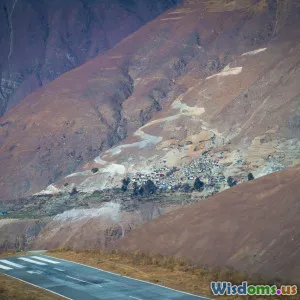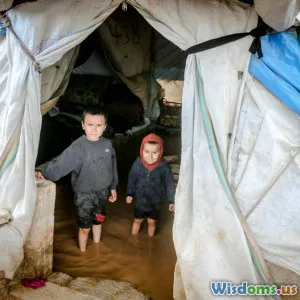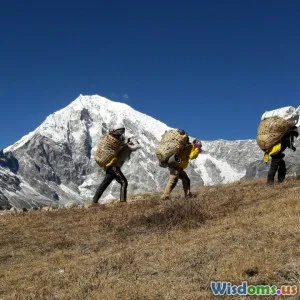
The Unseen Challenges of Delivering Aid to Himalayan Villages
8 min read Explore the hidden barriers to delivering aid in Himalayan villages and their profound impact on vulnerable communities. (0 Reviews)
The Unseen Challenges of Delivering Aid to Himalayan Villages
High in the towering Himalayan mountain range lie remote villages often untouched by modern infrastructure. These communities, while breathtakingly beautiful, face challenges that go beyond mere geography. When natural disasters strike or health crises arise, delivering aid becomes a monumental task often hindered by a web of logistical, environmental, and social obstacles. This article explores the unseen hurdles that humanitarian organizations and governments encounter while attempting to deliver aid to Himalayan villages.
Understanding the Context: The Himalayan Environment
Stretching across five countries—India, Nepal, Bhutan, China, and Pakistan—the Himalayas are home to thousands of villages scattered across rugged terrain. Here, altitudes rise above 4,000 meters in many regions, making temperature lows and oxygen scarcity everyday phenomena. Villagers depend heavily on local agriculture, livestock, and seasonal trade, and infrastructure such as roads or airports is limited or non-existent in many areas.
The geography itself presents the first formidable challenge. According to the United Nations Himalayan Alliance report 2022, approximately 60% of Himalayan settlements remain inaccessible by motor vehicles and require travel on foot or pack animals. This dramatically complicates any timely delivery of food, medicine, or essential supplies.
The Geographic and Climatic Barriers
Rugged Terrain and Limited Infrastructure
Glacial valleys, steep slopes, and narrow cliffside paths form natural barriers that obstruct access. Villages like those in Himachal Pradesh or the Dolpo region in Nepal can only be reached by trekking for several days. Road construction faces constant threats from land erosion, landslides, and seismic activity common to this young mountain range.
For example, the devastating 2015 Nepal earthquake rendered many mountain roads unusable just when relief was most urgently needed.
Severe Weather Conditions
The Himalayas experience extreme weather swings. Winters bring treacherous snowstorms that can isolate villages for months, while monsoon rains cause deadly landslides and flooding. These climatic factors delay or completely halt aid convoys. As a real example, in 2021, persistent monsoons blocked a key supply route to a village in northern Nepal, delaying famine relief efforts and impacting more than 5,000 people.
Logistical and Technological Challenges
Supply Chain Complexities
Maintaining a consistent supply chain is extraordinarily difficult. Aid organizations must pre-position supplies anticipating months-long inaccessibility, often relying on helicopters, which are expensive and weather-dependent. For instance, in Bhutan, small helicopter sorties carry essential medical supplies to remote clinics—an operation that can cost upwards of $500 per hour of flight.
Communication Gaps
Limited or no network connectivity exacerbates coordination challenges. Many Himalayan villages remain off the grid regarding mobile and internet coverage. Lack of real-time communication means delays in needs assessments, misallocation of resources, and inefficiencies in responding to emerging crises.
Social and Cultural Challenges
Local Customs and Language Barriers
Aid workers often face difficulties navigating local cultural contexts. Linguistic diversity—over 25 dialects in some regions—requires translators fluent in local languages, and miscommunication can compromise trust. Several NGOs have found that community engagement, led by locals trained as liaison officers, significantly improves aid uptake.
Community Trust and Participation
In some instances, lingering mistrust of outsiders and differing priorities complicate aid delivery. Sustainable aid requires involving villagers in planning and decision-making. For example, the Himalayan Health Initiative in Ladakh emphasizes participatory approaches, which led to improved vaccination coverage and water sanitation projects.
Case Studies: Successful and Challenging Aid Deliveries
The 2015 Nepal Earthquake Relief Efforts
The earthquake brought devastating destruction to thousands of mountain villages. Despite international aid pouring in, bottlenecks caused by blocked roads, extreme weather, and poor communication delayed relief. Grassroots volunteers played a crucial role by guiding aid workers through footpaths and acting as community mediators.
Innovative Solutions in Bhutan
Bhutan’s use of drone technology to deliver vaccines to remote mountain clinics demonstrates how innovation can overcome geographic barriers. This method reduces delivery time, cuts costs, and bypasses dangerous terrain—setting a potential model for other Himalayan regions.
Why Overcoming These Challenges Matters
Himalayan villages often lack access to basic health facilities, education, and disaster preparedness. As climate change increases the frequency of natural catastrophes and reshapes local ecosystems, vulnerability among these communities intensifies. Efficient and culturally sensitive delivery of aid not only saves lives but empowers these populations toward resilience.
Experts like Dr. Tenzing Wangchuk, a Himalayan development specialist, assert: “Without addressing the multifaceted barriers to aid delivery, even the most well-funded projects risk failing to meet the urgent needs of these high-altitude communities.”
Steps Toward More Effective Aid Delivery
- Infrastructure development focused on sustainability: Investing in weather-resistant trails and all-season roads can enhance year-round connectivity.
- Community empowerment: Training local volunteers and health workers ensures swift and culturally relevant assistance.
- Technological integration: Utilizing drones, satellite communication, and AI-driven logistics mapping optimizes resource allocation.
- International cooperation: Cross-border partnerships enhance resource sharing and unified disaster response in this transnational region.
Conclusion
Delivering aid to Himalayan villages is fraught with unseen challenges that extend far beyond difficult terrain. The interplay of geography, climate, culture, and technology creates a complex landscape for humanitarian efforts. However, emerging innovative solutions combined with community-centered strategies offer hope.
Understanding these barriers fosters greater appreciation for the Herculean efforts behind every successful aid delivery. It is a call to support adaptive and sustainable initiatives that protect and uplift some of the world's most isolated, resilient communities.
Sources:
- United Nations Himalayan Alliance Report, 2022
- Himalayan Health Initiative, Ladakh Field Reports, 2023
- Interviews with Dr. Tenzing Wangchuk, Himalayan Development Specialist
- Bhutan Ministry of Health, Drone Vaccine Delivery Pilot Program, 2021
- Nepal Earthquake Relief Logistics Review, 2015
Rate the Post
User Reviews
Popular Posts




















